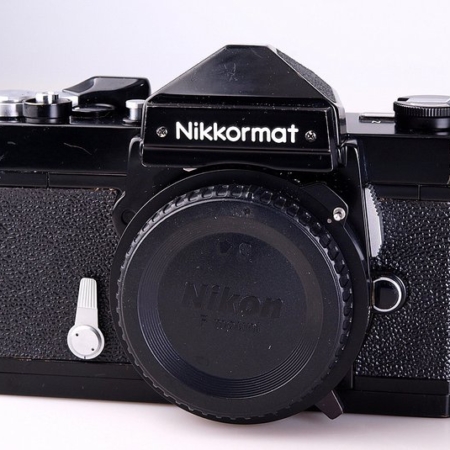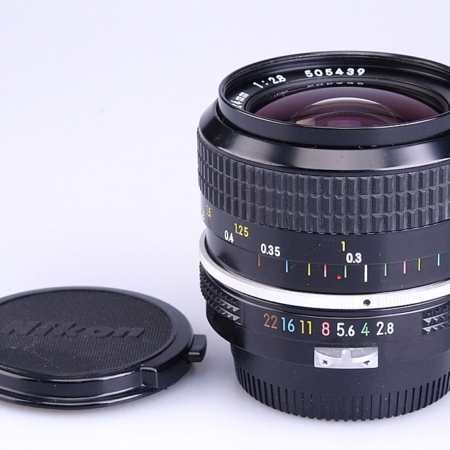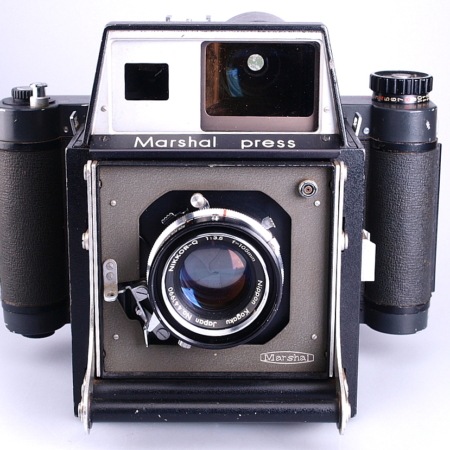Nikon F4 with MB-21 batterij pack and DP-20 finder
Nikon F4 is a 35mm film Integral-motor SLR system camera made by Nikon and produced between 1988-97.
The Nikon F4 was the third improved version of the original Nikon F which was introduced in 1959. It was replaced in 1996 by the Nikon F5. Some twenty years after its introduction it was still considered by many to be one of the most capable, tough and ergonomically brilliant professional 35mm SLR camera ever made. It is the last Nikon to accept the early Nikon F lenses without modification. This feature is a small steel tab on the aperture-coupling ring just behind the lens mount that can be folded away, released by pushing a chromed button next to it. Forgetting to engage the aperture coupling will either cause an “A” or an “FEE” indication in the finder using AI– and AF lenses, unless in manual mode.
The F4 operates with any lens ever made for the F-mount within the functional limitations associated with the lens put on the camera. The auto-focus works as focus-assist on most manual lenses at full aperture. Using pre-AI lenses, the stop down metering will apply. AI lenses may be used in Aperture-priority automatic exposure mode, while AF lenses can be used in Shutter-priority and Program-modes as well.
The F4 is larger and heavier than its predecessors, and is closely integrated with its accessories, especially its range of finders, backs and battery packs, to better adapt it to the task at hand. It weighs 1,5 kilogram (3.3 lbs) in its basic form ready to shoot with a standard F1.4 lens, while changing to MB21 adds 0.2 kilogram (0.44 lbs). The F4 is almost completely battery dependent, only film rewind may be performed manually, but it uses the universally available standard AA batteries, which should be fresh for trouble-free operation using the MB-21.
Lens release: button on the left side of the lens flange
Lens mount: Nikon F mount
Focus modes :
Manual focus with electronic rangefinder and Autofocus
Autofocus:
Autofocus detection system: TTL phase detection system using Nikon advanced AM200 autofocus module
Autofocus detection range: Approx. EV minus 1 to EV 18 at ISO 100 (under Nikon inspection conditions)
Autofocus actuation method: Single Servo or Continuous Servo
Autofocus lock: Possible by lightly pressing shutter release button in Single Servo AF mode or by using AF-L button; simultaneous use with AE-L button possible
Electronic rangefinder: Available in Manual focus mode with AF Nikkor lenses, Ai-type Nikkor lenses including Ai-modified Nikkor lenses and non-Ai-type Nikkor lenses with a maximum aperture of f/5.6 or faster
Exposure metering: Matrix Metering (with Multi-Meter Finder DP-20); Center-Weighted Metering (with Multi-Meter Finder DP-20 or AE Action Finder DA-20); Spot Metering (with any finder)
Exposure meter :
Exposure meter switch: Activated by lightly pressing shutter release button; stays on for approx. 16 sec. after lifting finger from button
Metering range: EV 0 to EV 21 at ISO 100 with f/1.4 lens; EV 2 to EV 21 with Spot Metering
Exposure control: Manual (M), and Programmed (PH, P), Shutter-Priority (S) and Aperture Priority (A) Auto Exposure
Auto exposure lock: Available by pressing AE-L button while meter is on
Exposure compensation: Possible using exposure compensation dial within ±2 EV range in 1/3 EV steps
Multiple exposure: Via a lever on the right back side of the top plate; setting: 1. Pull the multiple exposure lever toward you and release the shutter. The film will not advance. Multiple exposure lever is automatically reset to the original position. 2. Depress the shutter release button again to take the second shot. Film will advance to the next frame. For more than two shots on the same frame, pull the lever before each additional exposure.
Depth-of-field preview button: Provides visual verification of depth of field; can be previewed in Manual (M) or Aperture Priority (A) mode; coaxial with mirror lockup lever
Reflex mirror: Automatic instant-return type with lockup facility; to lock the reflex viewing mirror in the “up” position, push in the depth-of-field preview button and rotate the mirror lockup lever counterclockwise until it stops. (In this case, exposure meter cannot be used.)
his means that you can not operate the camera in any auto exposure and/or autofocus mode anymore (even if the viewfinder LCD may indicate information). Any indication of light by the LCD is a result of spurious light entering through the view finder eyepiece. However, you can make use of the camera’s suggested metering and use it in Manual mode.
Shutter: Electro-magnetically controlled vertical-travel titanium focal plane shutter; dial on the top plate, Manual and Shutter-Priority Auto Exposure modes
Shutter release: Electromagnetic shutter by magnet trigger, on the top plate
Alternate shutter release button: there is a shutter release button is provided at the bottom of the High Speed Battery Pack MB-21 as well as the Multiple Power High Speed Power Pack MB-23. This is convenient for vertical format shooting. The button can be locked to prevent inadvertent shutter release. Note: all F4 has another release terminal at the bottom rear section.
Shutter speeds: Lithium niobate oscillator-controlled; controlled from 1/8800 to 30 sec. step lessly in PH, P or A mode; set from 1/8800 to 4 sec. in one EV steps in M or S mode; B, T and X (1/250)
Viewfinder: Nikon Multi-Meter Finder DP-20 provided as standard; SLR pent prism, High-Eye point type; metering system selector, diopter adjustment knob, hot-shoe, compensation dial for focusing screens and eyepiece shutter lever provided; interchangeable with Nikon AE Action Finder DA-20, Nikon 6X High-Magnification Finder DW-21 and Nikon Waist-Level Finder DW-20
Viewfinder information: By LCD – exposure compensation value, frame counter (additive type), metering system in use, shutter speed, aperture, exposure mode, electronic analog display, AE Lock indicator; by ADR window – lens aperture; by LED display – focus indicators, exposure compensation mark and flash ready-light. Illuminator switch provided for dim-light viewing
Viewfinder illuminator switch: When it’s dark, use the viewfinder illuminator to light up all viewfinder information. Turn the switch on, and lightly press the shutter release button to illuminate the display. The illuminator automatically switches off as the viewfinder display disappears; it also momentarily switches off during exposure. Beneath the shutter speeds dial
Eye point: Approx. 22mm
Focusing screen: Nikon advanced B-type BriteView screen with central focus brackets for autofocus operation; interchangeable with 12 optional screens
Film speed range: ISO 25 to 5000 for DX-coded film; ISO 6 to 6400 in 1/3 EV steps for manual setting Film speed setting: At DX position, automatically set to ISO speed of DX-coded film used; manual override possible
Film loading: Film automatically advances to first frame when shutter release button is depressed once
Auto film loading: The user simply pulls the film leader to the mark closes the camera back then presses the shutter release button – and the camera automatically advances the film to frame #1.A bright LED will lit and stays on for approx. 16 sec. in such case, the film advance operation will halt as well.
Winding: In S (single frame) shooting mode, film automatically advances one frame when shutter is released; in CH (Continuous high speed), CL (Continuous low speed) or Cs (Continuous silent) shooting mode, shots are taken as long as shutter release button is depressed; shooting speed is approx. 5.7 fps (CH), 3.4 fps (CL) or 1.0 fps (Cs) – for Continuous Servo Autofocus, test done with an AF Zoom-Nikkor 35-80mm f/4-5.6D lens, new six AA-type alkaline batteries, shutter speed of 1/250 sec. or faster, at normal temperature.
Frame counter: Two additive types provided – on top of camera and inside viewfinder (LCD)
Re-winding: Choice of automatic or manual; automatically rewinds when film rewind levers (R1) and (R2) are used; takes approx. 8 sec. per 36-exposure roll (with six AA-type batteries); (with six AA-type batteries); stops automatically when film is rewound manual rewind when R1 lever is used
Self-timer: Electronically controlled 10 sec. exposure delay; blinking LED indicates self timer operation; cancelable; setting: via the last setting on the film advance mode
Hot-shoe: Standard ISO-type hot-shoe contact; ready light contact, TTL flash contact, monitor contact
Flash sync:1/60-1/250 in PH, P or A mode; in M or S mode, shutter fires at speed set and when set from 1/250 to 1/8800 sec., shutter is automatically set to 1/250; down to 30 sec. shutter is available by using SB-24, SB-26 or other equivalent Nikon speed lights etc. in rear curtain sync in PH, P or A mode Flash ready-light: Viewfinder LED lights up when Nikon dedicated Speed light is ready to fire; blinks to warn of poor camera/ Speed light connection or insufficient light for correct exposure
Flash PC socket: A separate sync terminal is provided on the Nikon F4. Use this terminal to attach flash units which do not have the standard ISO hot shoe.
Batteries: Four AA-type alkaline or NiCad batteries
Battery chambers: two, on the High Speed Battery Pack MB-21





